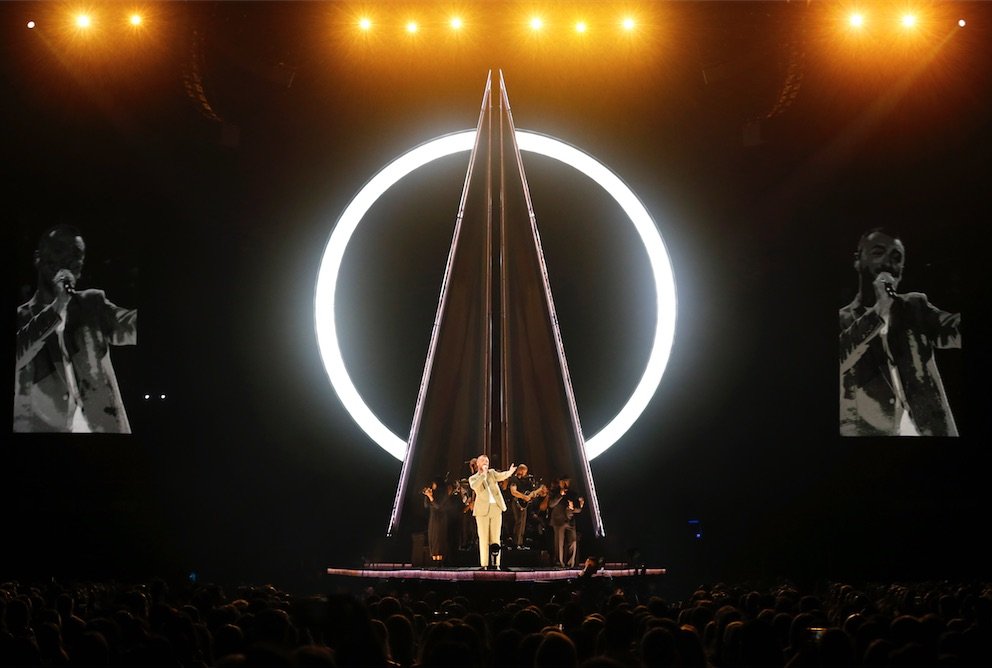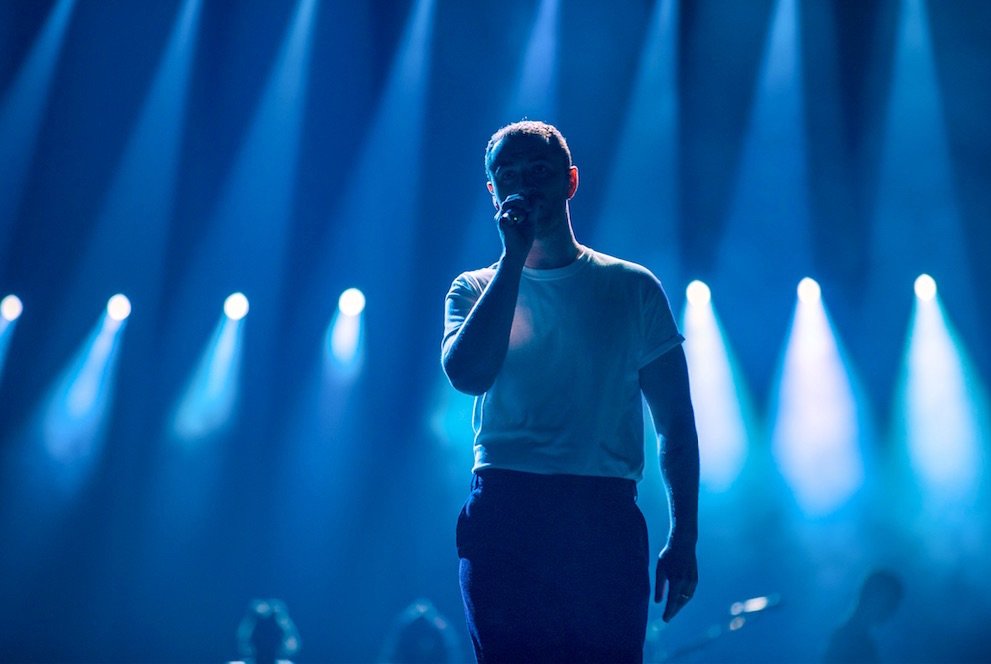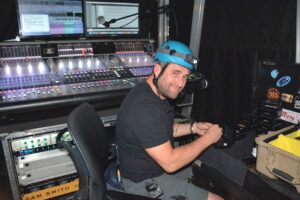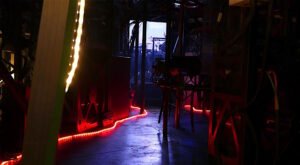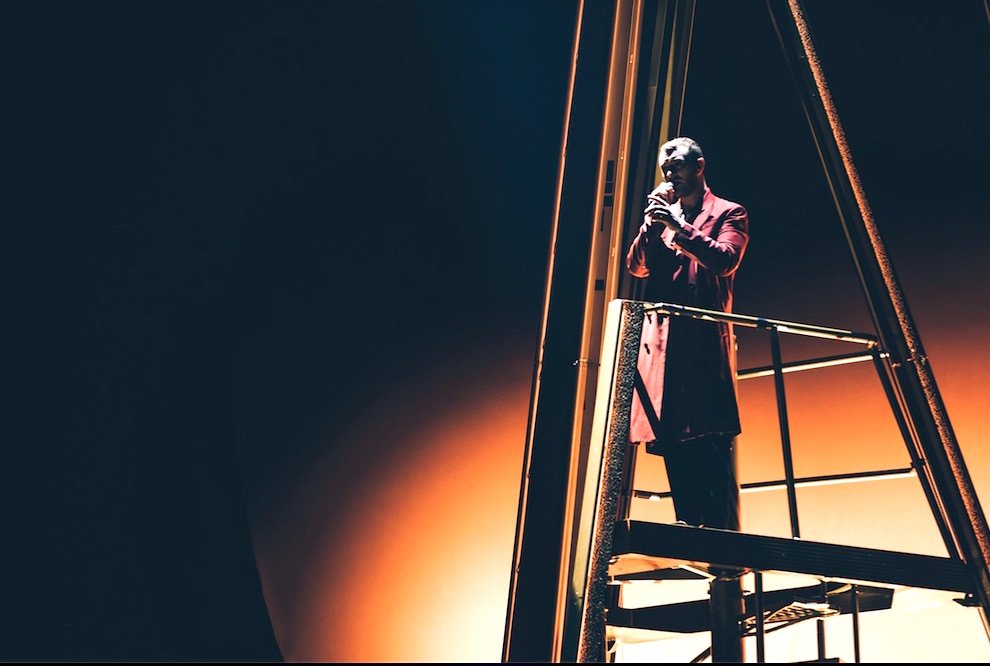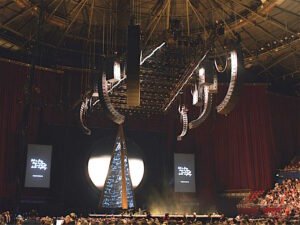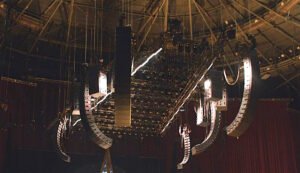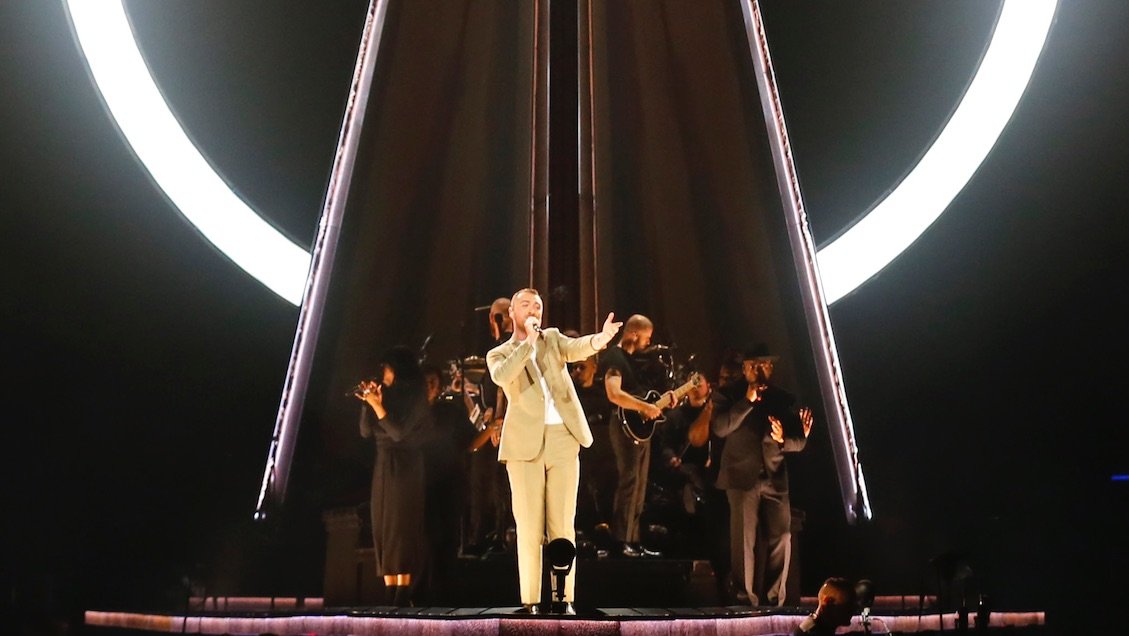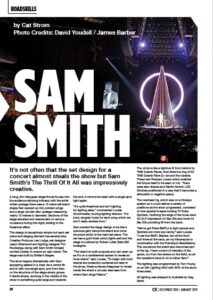News
17 Dec 2018
Road Skills: Sam Smith

Subscribe to CX E-News
ROADSKILLS
Sam Smith
by Cat Strom.
Photo Credits: David Youdell / James Barber.
It’s not often that the set design for a concert almost steals the show but Sam Smith’s The Thrill Of It All was impressively creative.
A long, thin triangular stage thrust its way into the audience allowing intimacy with the artist whilst upstage there was a 15 metre tall shard shape that opened up into pointed wings and a large circular disc upstage measuring nearly 12 metres in diameter. Sections of the stage elevated and descended on various occasions during the night, adding to the theatrical effect.
The design is deceptively simple but each set piece and staging element has several jobs. Creative Producer Lee Lodge, set designer Jason Sherwood and lighting designer Tim Routledge, along with Sam Smith himself, worked closely to ensure an epic result.
The stage was built by Brilliant Stages.
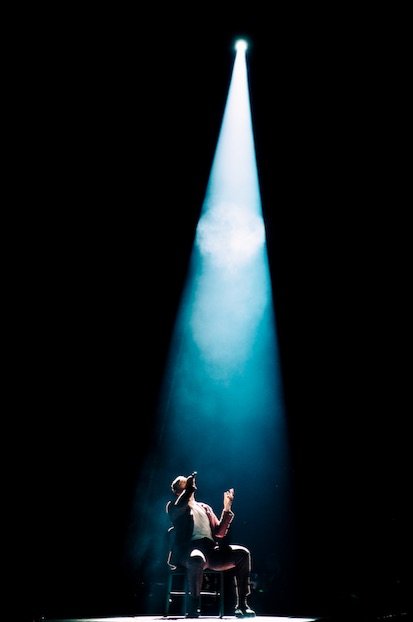 The show begins dramatically with Sam appearing seated in a chair via a centre lift and lit with one single spot, and from then on the structure of the stage slowly grows. It starts simply, evolving in the middle of the show to something quite large and towards the end, it mirrors the start with a single spot light again.
The show begins dramatically with Sam appearing seated in a chair via a centre lift and lit with one single spot, and from then on the structure of the stage slowly grows. It starts simply, evolving in the middle of the show to something quite large and towards the end, it mirrors the start with a single spot light again.
“It’s quite theatrical and isn’t lighting for lighting sake,” commented Louisa Smurthwaite, touring lighting director. “It’s bold, singular looks for each song which we don’t really deviate from.”
Sam wanted the stage design to be like a precious gem hence the shard and circle structure which is the main set piece. The set has a gold finish which lights well and the stage is outlined by Robert Juliat Dalis 862 footlights.
“The shard is multi-purpose and can open up as it’s on a cantilevered system to reveal an inner shard,” said Louisa. “To begin with both shards are projection surfaces but later in the show, these surfaces disappear to reveal inside the shard a circular staircase from where Sam sings Palace.”
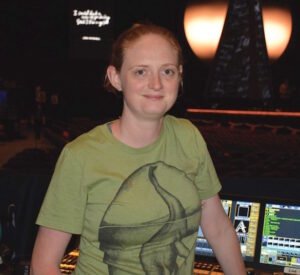
Lousia Smurthwaite, Touring Lighting Director
The circle is like a lightbox lit from behind by TMB Solaris Flares, then there’s a ring of 80 TMB Solaris Flare Q+ around the outside. These had Perspex covers which enabled the fixture itself to be seen or not. There were also drapes and Martin Atomic LED Strobes positioned in a way that it becomes a silhouette or negative space.
The overhead rig, which was on a Kinesys system so it could deliver a variety of positions as the show progressed, consisted of nine parallel trusses holding 75 Robe Spiiders. Outlining the edge of the truss were 52 GLP impression X4 Bar 20s and more X4 Bar 20s providing fill from the back.
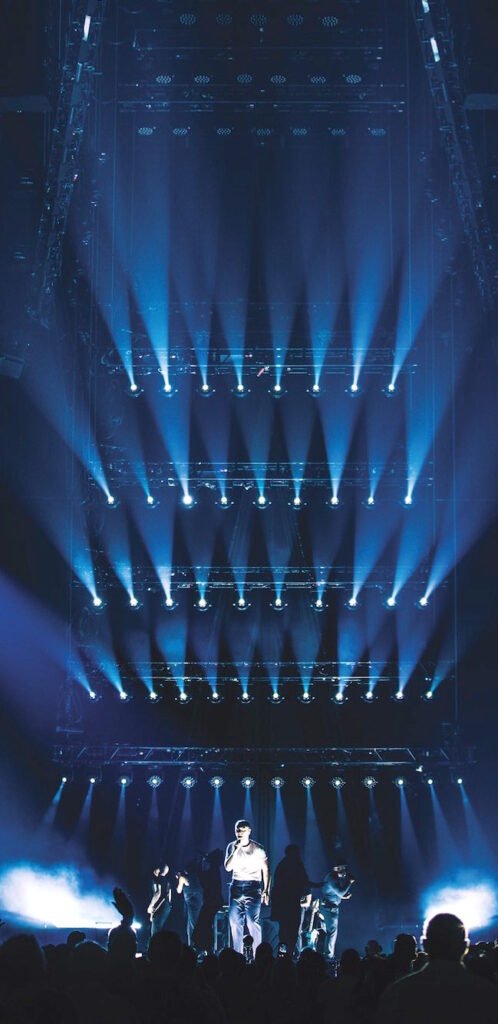 “We’ve got Robe BMFLs to light people and Spiiders are more eye candy,” said Louisa. “I use five BMFL Blades, two at the front and three at the back, as my followspots in combination with the RoboSpot BaseStation. The one above the shard also becomes part of the rig. I have control of intensity of the spots, run from five faders on the MA2, so all the operators have to do is follow Sam.”
“We’ve got Robe BMFLs to light people and Spiiders are more eye candy,” said Louisa. “I use five BMFL Blades, two at the front and three at the back, as my followspots in combination with the RoboSpot BaseStation. The one above the shard also becomes part of the rig. I have control of intensity of the spots, run from five faders on the MA2, so all the operators have to do is follow Sam.”
The lighting was programmed by Tom Young on an MA Lighting MA2 with 80% of the show timecoded. All lighting was shipped to Australia by Neg Earth.
In the bowels of the stage was Saul Skoutarides taking care of monitors with a DiGiCo SD7 because its automation is very versatile and useful for a show like this.
“I need the power of the automation to get it done basically,” he said. “I use Midas splits in front of the console because I like the sound of them and I’m using them as my actual gain stage; they do the splitting between monitors and FOH but I’m using them for their preamps rather than the ones in the console.”
- Saul Skoutarides, monitors
- Understage area
Two TC Electronic M6000s are used for various reverbs with Saul also using reverbs on the console. A Cranesong STC-8 compressor is inserted over Sam’s mix for some analogue warmth. “It’s a mastering buss compressor that sounds warm and lovely,” explained Saul.
“I’m also taking all my vocals AES through a Cedar DNS 8 Live – a digital noise suppressor that helps filter out big, boomy reverbs in arenas. Every day I listen to playback from FOH within the room, put all the mics on stage and basically teach it what the room sounds like. Then I can filter in or out as much of the room as I want in the vocal mics. It’s really been my savior on this tour as it’s essentially in the round.”
Eighteen sends of Sennheiser 2000 Series IEMs were used, keeping the stage clean. This is a model Saul has been using for the past ten years, even though there are newer models available. The vocal mics were Sennheiser SKM 5200-II wireless transmitters outfitted with MD 5235 capsules on them. All the band and Saul himself were using JH Roxannes for their moulds.
“There’s a lot of communication going on with 28 channels of shout mics, especially as we can’t see each other,” added Saul.
Capital Sound provided a uniquely configured d&b audiotechnik J-Series PA designed by system tech Liam Halpin. Obviously if the PA was hung in a regular left / right set up, Sam would be in front of the PA all night so Liam spent several weeks coming up with this design.
“When I first saw plans for the stage design I thought *&%$*$@#%!” laughed Liam. “It’s not an in-the-round show and it’s not a stage with a large thrust.
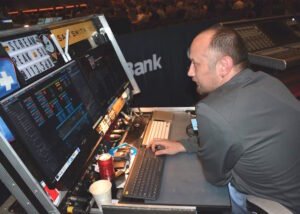
Liam Halpin, System Tech
“Most of my sound designs are based around the imaging, it’s always struck me as very unnatural if you’re looking at someone in front of you and you’re hearing them either from above you or to the side. Given that Sam was going to spend much of the show at the downstage tip of the stage, we realised very quickly that a traditional system would not work.”
Liam spent a long time using d&b ArrayCalc simulation software to model various options of array hangs to ensure consistent coverage for each audience member. With no subs allowed on the minimalist stage his job was made even more difficult.
“The side hang almost had to follow the line of the stage, to try do anything off-angle down the side of that stage wouldn’t really work,” said Liam. “So the side hangs became the first hangs locked into place and the sub array built up around that.
“Then came the challenge of trying to work out how to cover the front row of seats around the triangle. It was all based around trying to compromise between that throw and the imaging which is how we ended up with this design.”
The resulting hangs included 80 d&b J8s flown in 4 hangs of 20 cabinets, 32 d&b V8s flown in 2 hangs of 16 cabinets and 24 d&b J-Subs flown in 6 hangs of 4 cabinets. Added to that were 4 d&b J-Infra Subs under the stage and 4 d&b V-Sub, in 2 stacks of 2 cabinets, upstage. 22 d&b T10 cabinets were mounted to stage structure to ensure audience members by the catwalk were well covered.
Custom mounts to the side of the stage meant they did not interfere with the Dalis fixtures or clutter the stage. “The way they are connected gives me lots of control over the delays of individual boxes, although they’re not all individual boxes as some are circuits of four, but the groupings were arranged to give me the best possible control,” added Liam.
All flown full-range cabinets are driven by d&b D80 amplifiers and array processed. More D80 floor sub amps reside in a bay underneath stage right, upstage of the J-Infra subs. Every amp is connected to a dual, redundant Ethernet network using Dante equipped d&b DS10 network bridges controlled via Open Control Architecture. A Lake processing rack at FOH accommodates signal distribution and house EQ.
Using the d&b DS10s, Liam set up the system so the amps could monitor the signal flow via the Dante network. By the time production rehearsals begun in Lake Como, Liam had the PA designed and only minor tweaking was required. “We fine-tuned mixes and got everything dialed in,” begun Jim Ebdon, FOH Engineer.
“I did a mix on a pair of Genelecs in a studio environment, curious how it would translate to the d&B J system and it actually worked really well. I elected to mix off to one side so I’m really mixing in front of one line. It’s almost mono, I knew we were never going to get big stereo spreads so I disciplined myself mixing with very narrow stereo spreads, on the verge of mono.”
Jim chose a Solid State Logic SSL 200 to mix on, saying that he really favours the touch screens, which were essential for programming this tour. “I’ve been using SSL for about three years now because the mix buss has a characteristic sound to it that I like,” he said.
“I like that there is a lot of head room in the console and that it’s very easy to utilise Waves or Universal Audio products. It’s got options for MADI and optical outputs on the back so it’s very user friendly. I elected to use the SSL 200 for this tour as all the faders are in line for me and I just prefer the ergonomics of it.”
Jim used a Tube-Tech CL 1B compressor on Sam’s vocal as well as a Sonnox Oxford Dynamic EQ Plugin on the Universal Audio Platform because when Sam sings louder, his voice can become harsh in the high/mid-range.
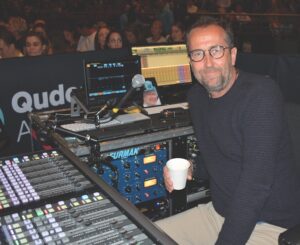
Jim Ebdon, FOH Engineer
“The Sonnox smooths that harshness out whilst keeping the integrity of the vocal sound,” explained Jim. “It’s a gorgeous vocal chain and I’m so happy with the way Sam’s voice sounds. I also have a Neve 1073 mic preamp at the front of the vocal chain. I use Bricasti M7 reverbs; one for Sam’s vocal and one for the drums.”
Jim used a Waves’ SG Extreme Server V3 with a selection of plugins for the main bus mix along with several Universal Audio plugins via a Soundcraft Realtime rack. “I love those plugins and everything else on the console,” commented Jim.
“I want to keep it as natural as possible because it’s a great live band with very little enhancements. I didn’t want to overdo it.”
The only slight challenge that Jim had was with the sub lows, he had to be careful how loud he ran the four J-Infras under the stage as anyone standing on top of them would lose their fillings!
“That’s really all the sub low that I have as all the bass is in the air,” he added. “So getting the volume right can be tricky as it’s not a loud show and I want to be able to hear the J-Infras on the arena floor and lower levels. It’s really all about Sam’s voice and keeping it natural-sounding.”
From the December 2018 – January 2019 edition of CX Magazine. CX Magazine is Australia and New Zealand’s only publication dedicated to entertainment technology news and issues – available in print and online. Read all editions for free or search our archive www.cxnetwork.com.au
© CX Media
Subscribe
Published monthly since 1991, our famous AV industry magazine is free for download or pay for print. Subscribers also receive CX News, our free weekly email with the latest industry news and jobs.

